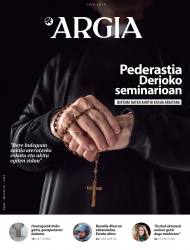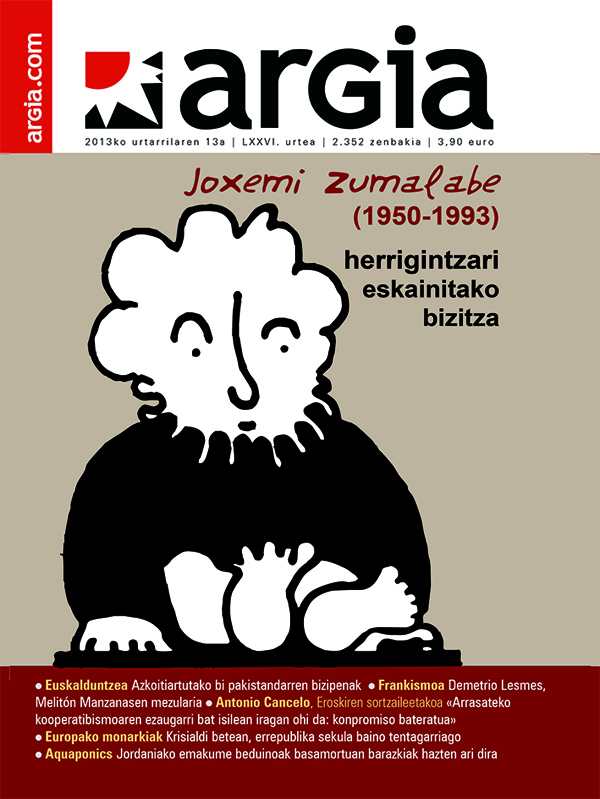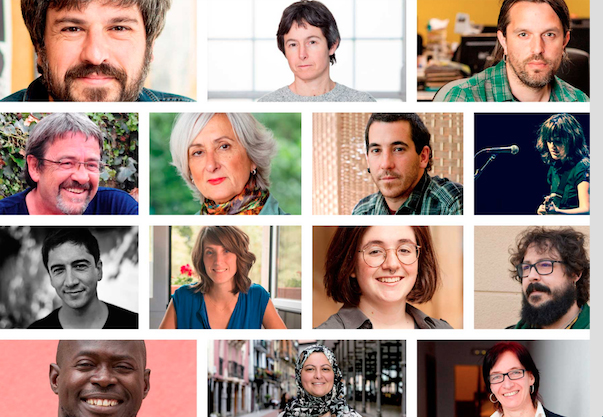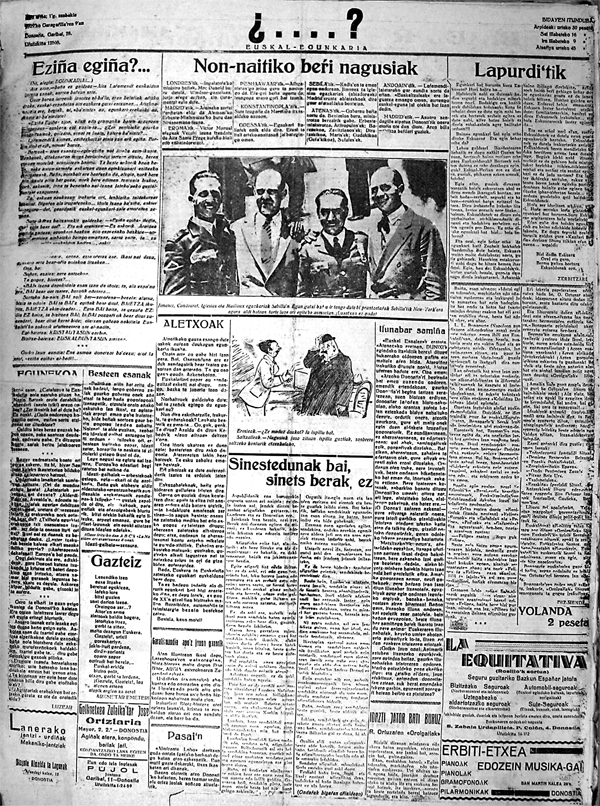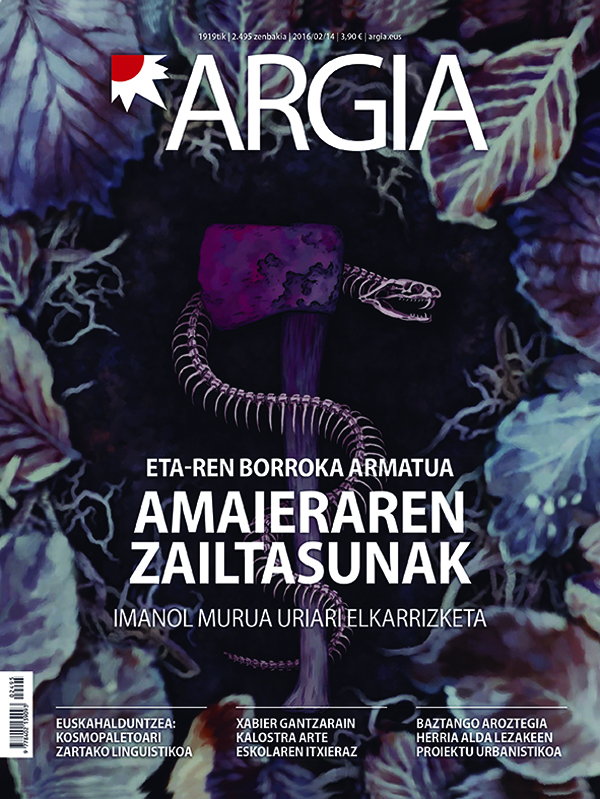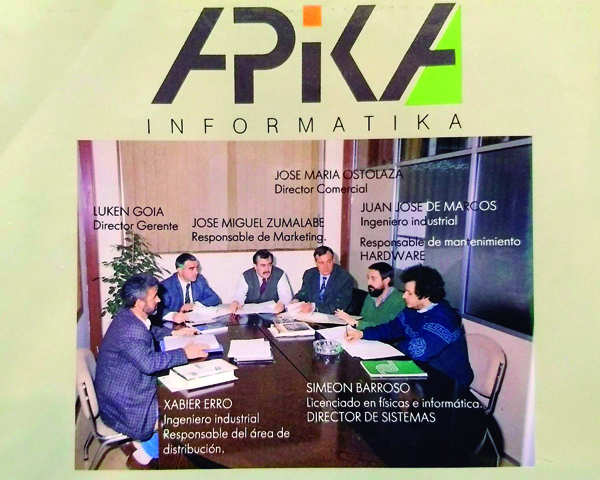A trip to the vasquity of Pamplona
- We returned to the cradle of Celestial Light on February 23. The world, the century, the people, all came together in Iruñea on a journey to the Basque head of the city that we organized to celebrate the centenary of ARGIA.
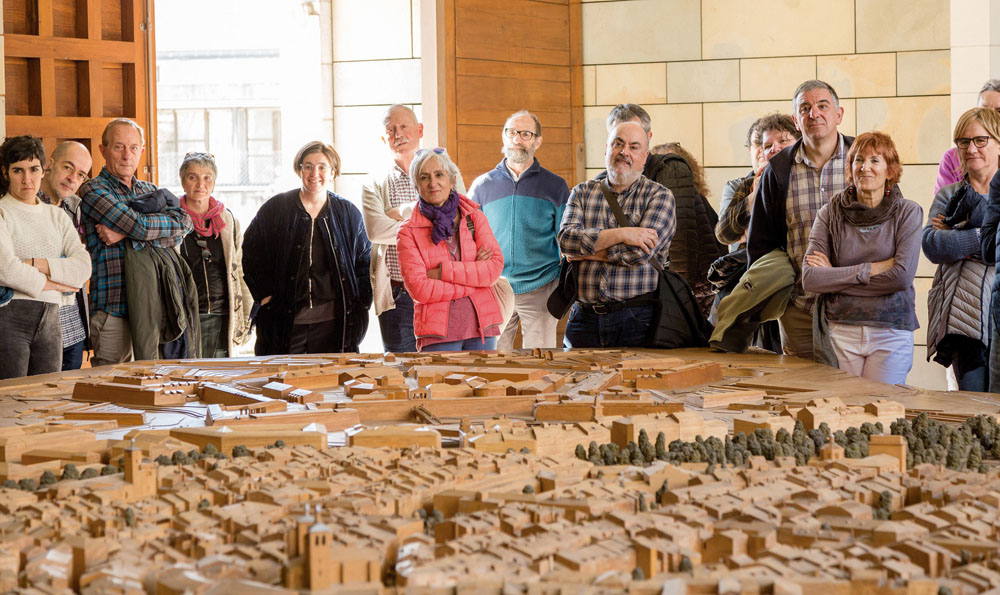
We go in a crew of about 80 people around the Arga River, at the rhythm of the trikitixa, in a joyful stroll. At the tip of a stick, Patxi Larrion, the precursor of all of them, a superb guide to the city, which takes us a century ago to spend the day that leads us to the future. The weather is also on our side, on 23 February it has gone sunny and saying sun in Pamplona is a lot to say: nowhere else does the Astro Mayor bathe the corners with the same color.
We started the morning in the monastery of the Capuchin monks, where in 1919 Damaso Intza and Aita Buenaventura were dedicated to connecting with the then Basques. A monthly religious journal, Celestial Light: The Astro Mayor, then accompanied by the crosses and the faith, has dyed the opposite from the Basque chronicles, but they have survived some delicate threads on which the equilibrist Iñaki Camino has walked, remembering the interview that he and Josu Landa had Intza in 1986. Miguel Olasgrip had been behind him for a century, which was his birth name, when in the 1980s two young men arrived with the engraver and the camera. He had a few months left in this world. The two young people crowded, after asking about the appearance of Celestial Light, they wanted to know if he slept well, if he dreamed, if he was healthy. And Intza replied. In their own way: “He was not inclined to the questions we had asked him. We asked him and he always made the question slip by his side. It was difficult to take it where we wanted it,” says Camino – and we say that we want to maintain that attitude after a century in ARGIA: an own agenda, immaculate, insubordinate.

So we've gone down from the headquarters of the Capuchins in the vicinity of the Arga River and gradually we've been gathering outside Arga -- the bar of the Rochapea, in this case -- as we approached, Arrotxan Kantuz's friends sang to ARGIA "zorionak zuri." Lunch, informal talks of all kinds and the reason for making this pit stop in this place: on the one hand, this bar that shows the identity of the neighborhood in each square meter is the meeting point of the Basques of the environment; on the other, as explained by collaborator Ivan Giménez, who for years spent the Plazaola train in the province, that is, to Gipuzkoa. In 1914 the iron snake was launched, which the Basques then called a push. So it turned five years ago. Connection made: We are where the 100 years are crossed and the road leading to the ARGIA headquarters in Lasarte-Oria.

Although not for a long time, in the Archivo de Navarra we have another date with history. We have arrived at Trikiti, Pandero and Fiesta and we have gathered around the model of the city that is at the entrance. It's Santi Leoné's time. You have read a quote to start your speech: “The Biscayan and Sulatino, brave and energetic, but at the same time rough, speak the same language, and only the space of a few days distinguishes one from another; in the nearby counties they use different words, but typical of the same language, to denominate the same things; the peoples that are very close are hardly understood, but they accept each other as brothers of a nation and of it.” Who said that? Teleforum Monzón? Tinkering? No:They are words of the wise Wilhelm von Humboldt, brought from Die Vask's book. From this work published in 1801, Leoné talked about how to name the Basques to this day and, specifically, about the development that the question of the Basque in Navarre has had: “The history of a large part of Navarre society is the history of distancing: from a Basque idea, it is the history of distancing from the Basque people.” But also now, “by the hand of ARGIA we see independence every week and we are here, in Iruñea, in the 18th century, as claimed by Etxeberri de Sare and Patxi Larrion in the 20th century, over the city of the Basques.”

That we have something between us, that we are all Basque or, as some say, we are all Navarros; or, by extending what Joxemiel Bidor said of himself to the whole crew, that here we have joined some Guipuzkoans from Pamplona, that we go somewhere, at the door of a store that is now closed on Mañueta Street – or at the beginning, where we look at them. In his honor we made a group photo before going to San Francisco Square. Estitxu Eizagirre and Ixabel Bereziartua waited for us at the base camp of ARGIA. After leaving the ginkana that we wanted to do in the Casco Viejo for lack of time, we shared memories for those who did not have to stay to eat and we made another photo on the stairs next to the facade of San Saturdi Street, dedicated to the Diana hunter, to finish the journey that we have started on the track of a cleric with the help of a pagan woman.
We expect lunch in the Maldi society. We're already hungry and thirsty. Imagine to what extent some people have started to have hallucinations: Some claim to have seen the Great Wyoming, the popular Spanish comedian, in the streets of the capital city. Fortunately, food and drink have come in time. And after making a balance, singing verses from the category, written by Subai Hill, see in the box below; and then more trikitixa and more conversations and some conspiracies that we're not going to count here. Before everyone leaves home, there is not much light left in the sky – and the LIGHT has not returned to heaven either; it forgives our debts, Damaso.
Ikertu ez, guk historia egin behar dugu. Arrapostu hori eman zidaten Zeruko Argiaren sorrera aztertu beharra zegoela proposatu nuenean, 80ko hamarkadaren akabera zen, Donostiako Mundaiz bidean ginen.
Azken hogei urteotan etxetik ehun metro eskasera izan dut kaputxinoen komentua, hurre duela 100 urte abian jarri zuten aldizkariaren artxiboa.
Iritsi da eguna. Bost lagun sartu gara Arga ertzeko Errotazarren, neguko eguzki gorriak gozatzen du patioa. Bertan, 1986ko irailean Iñaki Camino-Josu Landa bikoteak elkarrizketatu zuen Intzako Damaso, gu boston imaginarioan iltzaturik da enkontru haren argazkia.
Urre gorria dugu helburu. Miren liburuzainak eta J. Angel artxiboko arduradunak gidatu dute gure xerka. Damasoren artxiboa eskuratu eta miaketa hasi da. Oieregiko Buenabenturaren arrastorik ez, momentuz.
Bi ordu eskas eman ditugu agirien miaketan, tarteka erlojupekoan ari garela begitandu zait. Aitor dezadan, ez dugu urre gorririk kausitu, edo bai?
“Lokarri hori harrapatzera etorri ginen Josu eta biok” aitortu digu Caminok “Jatorrira bidaia” ekitaldian. Guk Damasoren gutuneria aztertu eta 70eko hamarkadako perla hauek bildu ditugu: “Z.A. deitzen den asteroko orrek orain ere beazunez betetako beste idazki bat argitara eman du…”; “Zeruko ez den horretan…”; “Z. A. askotan nazka eman didan seme biurri itzuli zaigu…”. Kritikoa zen zeruko hizki txikiz idazten zuten orduko kazetariekin, baina aldizkaria irakurtzen zuen.
Artxiboan arakatutakoen artean, Z. A.rekin zerikusi zuzena ez duen testuren bat. Araitz ibarreko gaztain motak izeneko saiakera, argitaragabea?
Beti ere, puskaz interesgarriena, Euskeraren Adiskideak elkartearen artxiboa iruditu zait. Baina nola iritsi da hori Damasoren artxibora? Gerrak euskalgintzara ekarri etenaren beste lekukotasun bat. Agiri horien artean “Euskaraz mintzatzen da” kartela eta horrekin batera gutun bat, merkatariak animatuz kartel hori jartzera, noiz eta 30eko hamarkadaren hasieran.
Egun Nafarroako ospitale publikoetan bada formula bat eriak sailkatzeko tenorean, “Paciente difícil de historiar” esaldiaren atzean euskaldun elebakar bat ezkutatzen da. Badute zer ikertu soziolinguistek.
Orduz geroztik lau aldiz bisitatu dut komentua, Historia etxetik hasi behar baita.
Patxi Larrion
Doinua: Jardin bat zuretzat (Xabier Lete)
-1-
Harresiak hesteetan
al daramatzazu?
Berlingoa hauts al da?
Tijuanakoa su?
Martxoaren 8ak
ehun al dauzkazu?
Gernika Monbar ote?
Aiete, Altsasu?
Nor aldatu da gehien,
mundua ala zu?
-2-
Joan ziren Maurizia,
Laboa, Xalbador...
ETA historia da,
eliza lur agor.
Jausi ziren dorreak,
erori zen Fagor;
Parisetik jadanik
umerik ez dator!
Zu nor zara munduan,
baina munduan nor?
-3-
Agian hartxintxar bat
botetan saltoka:
ez guztiz Bildu ta ez
aski EAJ.
Ez harra, ez emea:
biak, asko jota.
Ez homo, ez hetero...
Liga eta kopa!
Argia barroteen
artean dago ta.
-4-
Gurutzean eskegi
duzu San Balentin;
Hirutasun Santuan
bilatu lau erpin.
Nahiz eta bizitzari
zuk bertatik ekin
orain nor fidatzen da
sotanapeekin?
Aita hiltzeak kalte
ezin zizun egin.
-5-
Mozalei hozka inoiz
ez denez gaur bera
bide itsuan ere
zu beti aurrera,
etsi gabe inoren
esku-ahurrera;
euskararen begian
gorria urre da.
Ez zinen atzo jaitsi
zerutik lurrera.
-6-
Jasotakoa libre
utziz oinordetzan
bat eta bat hamaika
dira lankidetzan.
Kontraesanak altxa,
botereak etzan!
Zaildu ez ezik zaindu,
agindu ez, esan,
euriak ere behetik
gora egin dezan.
-7-
Ez zaio hitz gutxitan
luma anitz ari
‘sentimentatzen’ joan
den giza flysch-ari.
Altabozik gabeko
kausen zerbitzari,
bere handitasuna
eman bizitzari
eusteko zero zabor
kazetaritzari.
-8-
Gartxotez gogoratzen
ote da Itzaltzu?
Ze herri dira Sara
eta Arantzazu?
Paperezko hesterik
ba ote daukazu?
200 betetzean
esango didazu,
nor aldatu den gehien,
mundua ala zu.
Sustrai Colina (2019ko otsailean)
2019 has been a special year for ARGIA, an example of this is this number that you have in your hands. Turning a hundred years is not an easy achievement, even more so for a small media outlet in Basque. The celebrations have taken different forms throughout this year and, as... [+]
On the day of the presentation of book 111 Hostoz eta Orriz we had the opportunity to learn about the culture of Duzunaritz. A delicious day to round off a series of celebrations that fill the century of Argia. I can't imagine a more beautiful path than to dirty the shoes in... [+]









